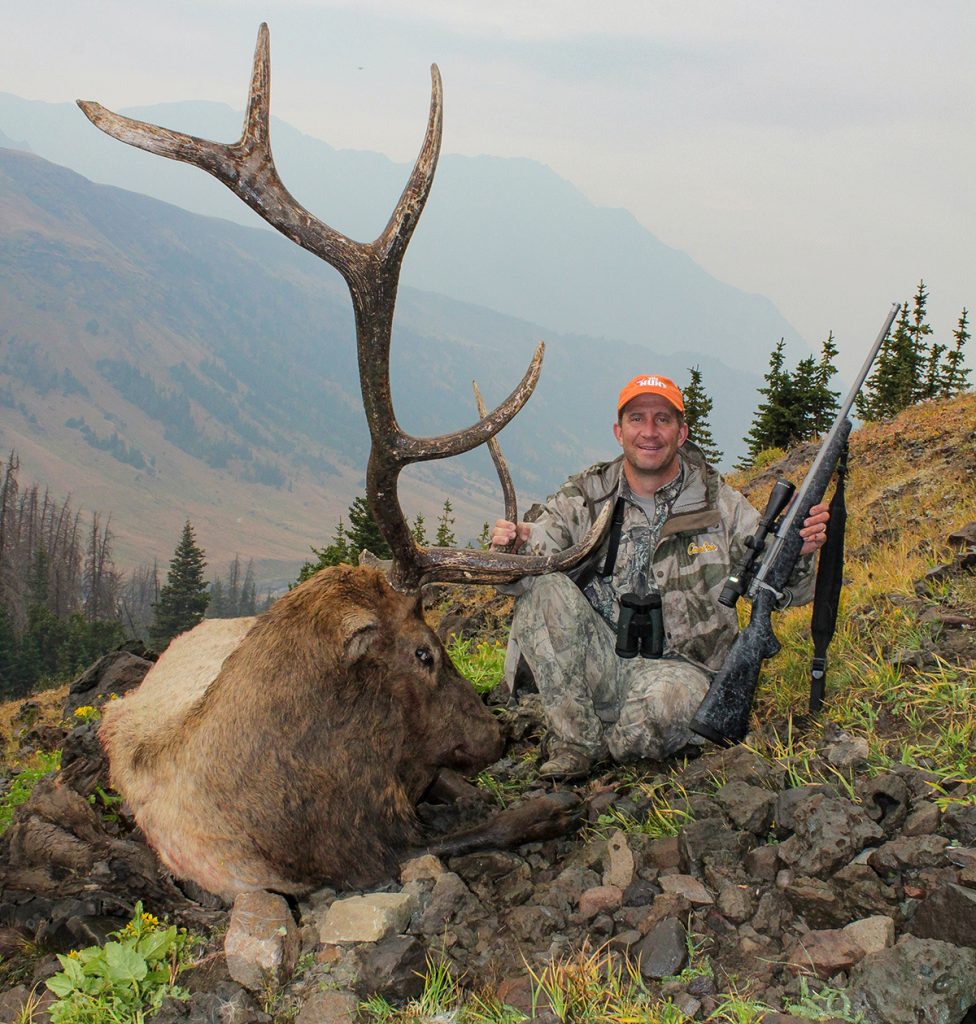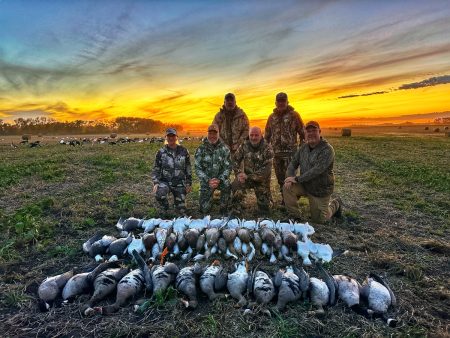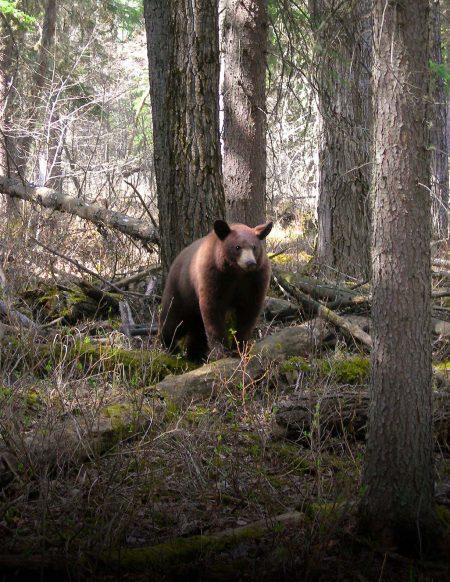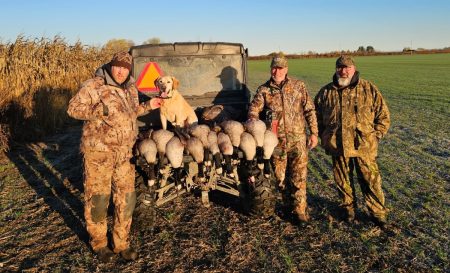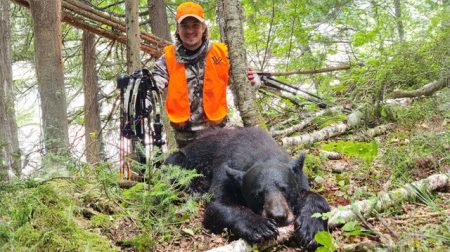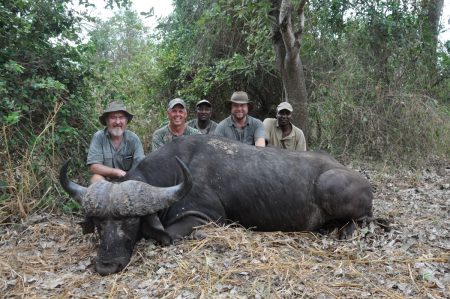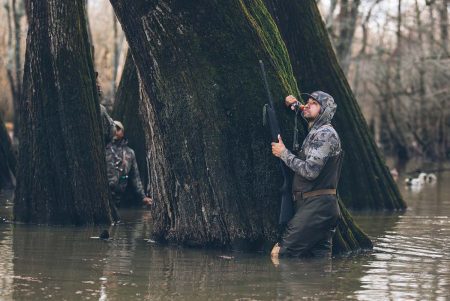Wyoming Elk Hunting
Struggling to reach the top of the mountain, my tight, throbbing lungs worked hard. I was prepared for the challenge, but my body still felt the pain that comes with trudging up near vertical shale slopes at 10,000-feet elevation. One last pause to catch my breath and ease the burn in my legs, and finally I reached the rock I’d been eyeing. Tossing my pack onto the tundra-like turf, I was awestruck with the captivating view from so high.
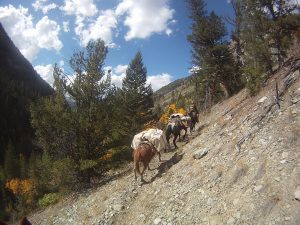
“You made it,” smirked JJ, my longtime buddy and hunting partner on this trip who’d already recovered from his ascent. JJ guides horseback adventure all summer and big game hunts in the fall, he’s in top shape. He’d been glassing for several minutes before I reached him. From atop the mountain, I glanced into a bowl along the edge where we sat. A band of bighorn ewes fed across the flat. Above them another band of more than 30 sheep grazed and above those, rams could be seen soaking up the morning sun in their granite beds.
I felt honored to be in this land, a place where the famed Jack O’Connor once took a ram. But this hunt was not about sheep. On this hunt I held a general season Wyoming elk tag and the quest to fill it on public land, at extreme elevations, was wherein the challenge lied. I’d hunted with JJ before. Our last adventure took us after late-season bull elk in Wyoming’s coveted Unit 58. We made good on that horseback hunt and vowed to hunt together, again. Here we were.

After securing a general season tag in the lottery, plans were immediately being made. “This isn’t an ordinary elk hunt,” JJ warned. “We’ll be going into areas where I have seen big bulls during September sheep hunts, so you’ll want to be in top shape and prepare to rough it.”
Pumping iron, running, biking, hiking and eating a healthy diet is a normal part of my lifestyle. But training at 500-feet above sea level in my hometown of Oregon, is far different than hauling my 200-pound body, loaded pack and rifle in the mountains at 10,000-feet. Early on, the horses did the work, getting us first to base camp, then to spike camp. I’ve been on many horseback hunts over the years; I love and hate them. Without horses we’d not be able to reach such rugged land, but the danger that constantly looms with hauling a pack string into the wilderness is always present. I’ve seen ugly wrecks, and continually prayed we’d not encounter one on this trip.
The ride into the Washakie Wilderness was the most rugged I’d been on. The towering peaks resembled many places I’d seen in Alaska and New Zealand, with trails more challenging than anywhere I’d ridden in British Columbia. But the five horses and one mule did not skip a beat. Though the ride was only 16 miles, the extreme ruggedness of the country took us two days to reach spike camp. From there, another three miles found us in elk country.
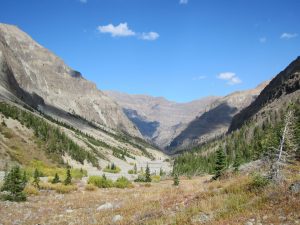
After a good night’s sleep under the star-filled sky we awoke to unseasonably warm temperatures. “Last year on opening weekend we had freezing temperatures and several inches of snow,” JJ smiled. We weren’t complaining about the warm weather on this early October day. Saddling up the horses we rode two miles into the head of the drainage. As we neared our check point, a string of horses headed our way, a large ram skull tied atop a mule. “There were a lot of bulls around last week,” noted the sheep hunters, “but they moved to the head of the canyon or over the top into other drainages.” They hadn’t seen an elk in five days.
Rather than hunt the vast, broken-timbered mountains as originally planned, we worked the horses straight up the hillside so we could glass across distant canyons. “I know that hillside is more open, but it’s the only place elk will be if they’re even still in this valley,” JJ reasoned. Taking the horses as high as we could, we covered the last half-mile of the ascent on foot. Glassing across the valley to the opposite hillside, JJ shared story after story of rams they’d taken in this drainage over the years. “We once showed a governor’s tag holder over 30 rams before he found the one he wanted, and that was right over there,” JJ pointed.
Sitting in silence my mind drifted back to my stomping grounds of Alaska’s Brooks Range, where I used to live a subsistence lifestyle. Here I’d taken many Dall sheep over the years in areas that looked identical to where we sat in Wyoming. I reflected on the similarities of the tahr and chamois hunts in New Zealand I’d taken over the years, and wondered how many people really knew how rugged the Rocky Mountains could be in this part of the country. “There’s a bull,” piped JJ, snapping me out of a daze. “There’s another one.”
Quickly the best spotting scope I had was in position, and we started studying the bulls from over a mile away. A small 6×6 and two rag-horns were all I could see. Over the next two hours we found a few more bulls, but only two cows. Two weeks prior some of JJ’s guide buddies had been in the area and saw a 360-inch class bull with nearly 20 cows. A half-dozen satellite bulls in the 300 to 320-inch range were also in the valley, but we were not finding them.
We caught a second wind and moved to higher ground where we spotted three more bulls, but no big one. Then, emerging from behind a small clump of pine trees, two bulls trotted into view and began sparring. Instantly, the brow tine of one stood out. But a closer look revealed it was missing the entire left side of the rack, above that impressive tine. We watched as the two bulls sparred, rested and fed.
“That tine’s got to be 30-inches long,” JJ exclaimed. The right side of the bull’s rack was solid and heavy, and had it carried a match to it on the other side it would have been an awesome bull. “What do you think?” JJ quizzed. I hadn’t thought about taking that bull, hoping to instead find the 360” bull rumored to be in the area. With all the sheep hunting activity that had been going on in that valley, however, and the fact we’d not seen any good numbers of cows, the chances of big bulls being there seemed slim, we both agreed.
Furthermore, the fact these bulls were hanging out alone, confirmed their natural cycle for this time of year had been disrupted, likely by the presence of man. The bulls should have been with cows.
Looking closer at the Dagger Bull, as JJ dubbed it, I reevaluated things. What caught my eye first was how battered its body was. Even at that distance, fresh, bloodied, battle scars stood out along its neck, body and rump. No question a bigger bull had whipped the Dagger Bull.
I let out some cow calls and bugles, hoping to elicit a distant bugle. All was silent.
Moving camp to another drainage would take two days, leaving us short on time. “Let’s go after that bull,” I told JJ. “I’m glad you said that, because if you did’’t want him, I’d take him,” JJ confirmed. JJ also had a tag, one he purchased over the counter as a resident.
Quickly losing elevation, we gathered the horses, led them down the steep hillside, rode a mile up the valley and tied them in some pine trees. From there we hiked up to the timbered edge where we’d last seen the Dagger Bull, but there was no sign of it.
Moving farther up the ridge, JJ spotted a spike, then another. Then the 6×6 the Dagger Bull had sparred with stepped out. It was a young bull, not worth a second look. “The thing’s gotta be there,” JJ whispered.
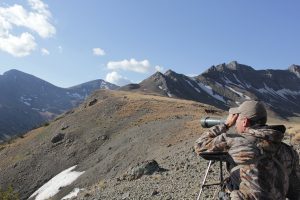
Picking our way through sparse pine trees along the bottom edge of a rocky outcroppings, we worked fast to cut the distance. “This is as close as we’re going to get,” JJ confirmed. A quick reading on the rangefinder showed 225 yards, but the steep, 45º uphill angle made getting a secure rest a challenge.
Bunching my pack into a wad, feet oddly planted in rocks, I rested my Nosler custom .325 WSM into position. Placing the green dot of my Trijicon AccuPoint low on the bull’s shoulder, I compensated for the extreme rise in elevation. Though I lost sight of the bull in the recoil, the resounding thud of the 200 grain AccuBond finding its mark confirmed a hit. A quick follow-up shot put the bull down for good. Climbing up to the downed bull, it was obvious the hardest part of the hunt was yet to come. The bull had slid into a rocky ravine and teetered on the edge, its entire body balanced atop the one full antler that was wedged in the rocks. Trying to keep the bull where it’d come to rest, the instant JJ and I budged it, it broke free and started sliding down the rocky chute. Tumbling end over end, the bull finally lodged against a rock 125 yards below, it’s rack still in-tact. The effort we put in to getting this bull was the real trophy of the hunt, along with the fine eating meat. Where the bull lay we had no choice but to bone it out and pack it down to the horses.
The ride out of the wilderness was not without tense moments. Rough trails and steep ground took their toll on our bodies, and the horses. They were the best horses I’d ever ridden, period, and JJ was the best horse-handler I’ve ever had the honor of hunting with.
The rewards of this hunt came in many forms, not the least of which were overcoming daunting mental and physical hurdles from start to finish. To hunt elk in a land designed for sheep is a remarkable experience, one that must be lived in order to be fully appreciated. The fact my bull was one side short of a full rack didn’t matter either, as some hunts are simply about much more than what the headgear scores.
Per our affiliate disclosure, we may earn revenue from the products available on this page. To learn more about how we test gear, click here.






